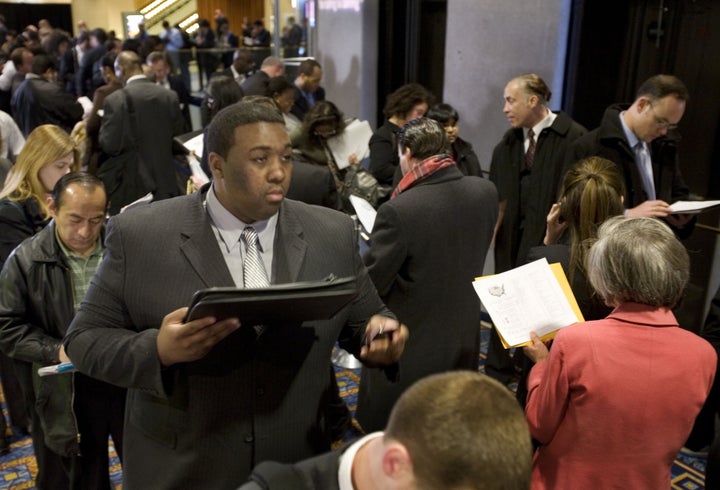
I'm no economist, though I've worked with plenty of them. As a public interest and public policy PR consultant, the economic indicators I notice most are perceptual and rhetorical: things like the steady uptick in comparisons to the Great Depression, and the new CNN/Opinion research poll that says concern over unemployment has tripled in recent months, making it the top economic issue facing Americans. I also note the unemployment worries have prompted some counterspin, for example the claim by Christina Romer, head of the National Council of Economic Advisers, who says current unemployment is not really so bad that it bears comparison with the Depression. Here's an NPR Morning Edition piece about that.
This leaves some cognitive dissonance in the heads of us non-economists, who have to wonder, poll numbers and competing expert claims aside, how bad is unemployment now, in based on the evidence?
The answer, as I've discovered working on employment policy issues, is much worse than we think. It's not just the latest dismal Bureau of Labor Statistics (BLS) numbers showing the highest unemployment in over 25 years, and 4.4 million jobs loss since the recession started in December 2007, 2.6 million in the last four months, with well over half a million jobs hemorrhaging month to month. It's not even the fact that the job loss is unusually broad-based, cutting across American industries, demographics and geography.
The worst of the bad news about American unemployment - and the yet worse news sure to come -- is that it is part of a huge, submerged structural problem, an iceberg with which our titanic fiscal and monetary policy mistakes have long been on a collision course. For many years we have propped up consumer spending through debt and inflated home equity, while virtually ignoring job creation. The Bush years produced only 4.8 million new jobs, not nearly enough to accommodate population growth. And for half a century we have been accustomed to funding entitlements with ever growing, highly regressive payroll taxes which cannibalize jobs. That left us with a structurally weak job market even before the current crisis began.
Official unemployment is now 8.1% (officially 12.5 million Americans), which sounds high, but manageable compared to the double digit rates Boomers remember. After all, unemployment topped out at 10.8% when I graduated from college in late 1982. A source for the NPR piece who remembers the 1930s said, "I don't like the comparisons with the Great Depression, because you're comparing 7.5-8 percent unemployment to 25 percent unemployment."
But in fact, if you make an apples-to-apples comparison, current unemployment is much worse than the early 1980s and within striking distance of Depression era rates, because our ever narrowing official definitions of who is officially unemployed chronically mask the severity of the problem.
For example, in 1994, the Bureau of Labor Statistics decided not to count those out of work for a year or more (4 million people at the time). The Clinton administration also reduced household sampling in the inner cities which probably further undercounted unemployment, especially among minorities. The Bush administration used largely the same measures.
But according to statistician John Williams, whose Shadow Government Statistics tracks and corrects political biases in government stats, if we revert to the same criteria that were used in 1994, before the criteria changed, today's unemployment rate wouldn't be 8.1%, it would be 19.1% (almost 30 million Americans). Many analysts expect to see official 9.4% unemployment by the end of 2009. By pre-1994 measures, that would be equivalent to 22.5% (almost 35 million Americans). Goldman Sachs and others forecast 10% or higher official unemployment by the end of next year. By pre-1994 measures that begins to approach 1930s Depression rates of 25% unemployment, and something like 40 million unemployed!
Believe it or not, that's not even the worst of it. According to the employment policy group Get America Working!, for which I consult, and which Hendrik Hertzberg has written up in his current New Yorker piece, if you disallow creative redefinition of who is and is not considered part of the workforce, the true number of unemployed Americans could be higher still.
There are 75 million nonworking Americans aged 16 to 75 who are not in the military or institutionalized, who are at least potential members of the workforce. Among them, a disproportionate number of women, minorities, seniors, youth, people with disabilities and legal immigrants are under- or unemployed. No one knows exactly how many of them would be willing and able to work if jobs were available, but it is safe to say tens of millions, perhaps the great majority of the 75 million. As long as there aren't enough jobs to engage them, their potential contributions to the economy are still being lost, which hurts us and them, whether they are officially counted as unemployed or not.
President Obama proposes to create or preserve 3.5 million new jobs through stimulus spending, tax cuts, small business loans, government hiring including a million census takers, and other measures. These steps are deeply necessary and long overdue, but also woefully insufficient to address a structural problem that includes an overhang of tens of millions of Americans who aren't working.
To change the larger equation, the US should consider doing what EU countries have done: make deep cuts in payroll taxes to stimulate the economy and job growth. Payroll taxes raise hiring costs and structurally depress jobs. But they also fund Social Security and Medicare, so changing them has long been shunned as the "third rail" of American politics (touch it and you die). Yet amid the economic crisis and hitherto unthinkable bailout packages the "third rail" stigma has faded, and rethinking payroll taxation has been promoted from beyond the political pale to "Not Insane," the title of the Hertzberg New Yorker piece which explores it.
Hertzberg finds that the practice of funding a huge chunk of the federal budget through "a direct tax on work and workers--on jobs per se" is what's crazy. But meanwhile, major payroll tax cuts are built into Obama's budget proposal. About 80% of the $645 billion the Obama administration proposes to raise through cap and trade revenues over 10 years would be used to cut payroll taxes, so working families won't suffer unaided from higher energy costs.
Why single out payroll taxes? First, are the biggest tax three-quarters of Americans pay, and also the most regressive, so cutting them helps middle class and working poor families more than cutting other taxes.
Second, historically payroll taxes have careened out of control, ballooning from one percent of Federal revenues in 1936 to over 35% today. Our addiction to payroll tax revenue has powerfully distorted the effective price of labor relative to non-labor inputs to business, such as energy and natural resources, rendering pollution and energy waste too cheap and hiring people too dear. The current relative price distortion could be 30% or more. It's a defensible statement that this distortion has been a deep, hidden, structural cause of our environmental and economic problems, and has helped create the conditions for both climate change and massive unemployment.
But we may finally be on a political path to reversing it. Early adapters on both sides of the aisle from Al Gore to T. Boone Pickens, Thomas Friedman to Charles Krauthammer, Eugene Ludwig to Lawrence Lindsey, have long understood the structural problem and advocated payroll tax "shifting" -- PRT cuts coupled with some form of higher energy taxes. They were outliers, but they are looking increasingly mainstream.
It means that after decades in the wilderness, the economic and climate crises have forced Washington to seriously consider embracing the "third rail" and shifting the tax burden from employment, which we urgently need more of, to an undesirable like carbon emissions, which we urgently need less of. If the federal government manages to take payroll tax shifting all the way from "third rail" to "Not Insane" to enactment, it will not only make the tax code fairer, it will also drive down carbon emissions and create many, many millions of jobs. What would be insane, at this point in history, would be to lose this opportunity to do so.It's 'way too early to celebrate climate legislation as if it were a fait accompli, and we are still in for a politically tough, complex debate on the specific merits of taxing vs. trading carbon, and on exactly how the revenues will be used. But the fact that payroll tax cuts are big parts of both the White House cap and trade proposal and competing carbon tax proposals (pending carbon tax legislation would use 96% of revenues to cut payroll taxes, vs. 80% in Obama's cap and trade proposal), and that payroll tax cuts are coupled with new taxes on a non-labor input to business (carbon fuels) is an epoch-making sign of the times.
